Laser diode (LD), also known as, an injection laser diode (ILD), or diode laser is a semiconductor device that is similar to a light-emitting diode that emits a single wavelength or, in some cases, a short band of closely spaced wavelengths.
Index
What is a Laser diode?
A laser diode is a semiconductor device that produces high-intensity coherent light. LASER is an abbreviation for Light Amplification by Stimulated Emission of Radiation.
The operation of this diode is based on stimulated emission.
The P-N junction of a laser diodes are similar to that of an LED; but, unlike LEDs, the P-N junction of a laser diode emits coherent radiation.
Symbol of Laser diode
The laser diode’s symbol is

Construction of Laser diode
- It is formed by doping gallium arsenide material with aluminium or silicon to provide n-type and p-type layers.
- In addition, an additional active layer of undoped GaAs is wedged between the two layers.
- This active layer is just a few nano-meters thick.
- The aim of wedging this layer between the p and n-type layers is to increase the region of the electron-hole combination.
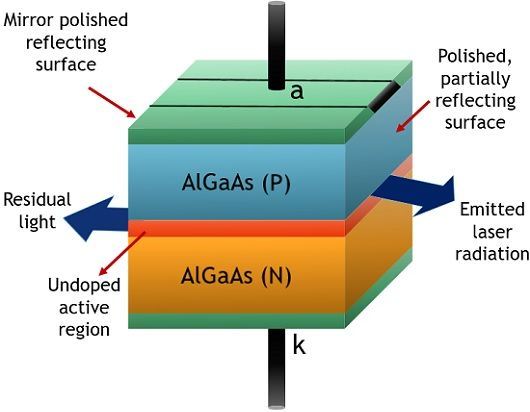
- As a result, the amount of radiation released increases. The laser output is obtained from the laser diode’s active region.
- Polishing is provided at the two ends of the junction in laser diodes to provide a mirror-like surface.
- More electron and hole pairs are formed as a result of reflection from this surface. As a result, more radiation is produced by the device.
Working of Laser Diode
Laser diode’s working is divided into three major steps:
Absorption of Energy
The laser diodes are made up of a p-n junction that contains both holes and electrons. (A hole indicates the lack of an electron under this context.) When a voltage is applied to the p-n junction, electrons gain energy and move to a higher energy level.
Holes are formed in the excited electron’s original position. The electrons remain in this excited state without recombining with holes for a relatively short period of time, which is referred to as the “recombination time” or “upper-state lifetime.” Many laser diodes have a recombination time of around a nanosecond.
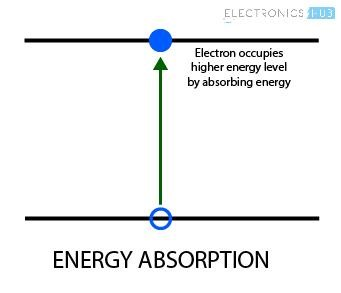
Spontaneous Emission
Excited electrons recombine with holes during their upper-state lifespan. The disparity in energy is converted into photons or electric radiation when electrons fall from a higher energy level to a lower energy level.
LEDs use the same method to generate light. The disparity between the two energy ratios gives the energy of the released photon.
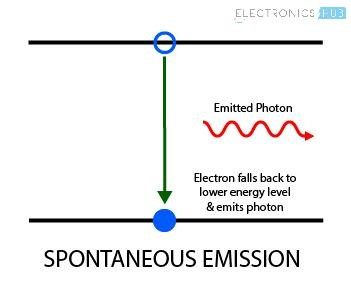
Stimulated Emission
We need more coherent photons from the laser diodes than those generated by spontaneous emission. A partially reflecting mirror is used on either side of the diode to capture photons emitted from spontaneous emission in the p-n junction before their concentration exceeds a threshold value.
These trapped photons stimulate excited electrons to recombine with holes well before their recombination period. This causes the release of more photons that are in exact phase with the original photons, amplifying the output.
When the photon concentration exceeds a certain threshold, they escape from the partially reflecting mirrors, producing vivid monochromatic coherent light.
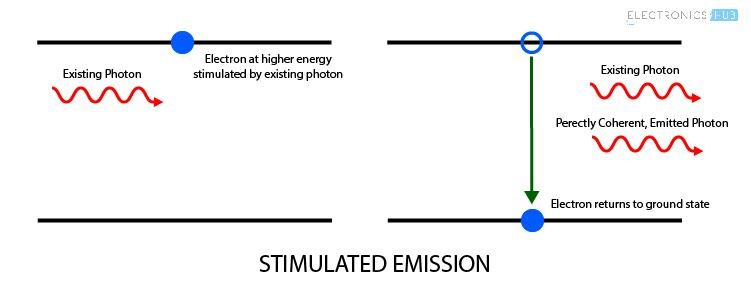
Characteristics of Laser diode
L-I Characteristics
- The light energy increases with increasing laser current, but it is temperature-dependent.
- The curve clearly shows that after a certain threshold laser current, the light energy increases. This laser current threshold value rises exponentially with temperature.
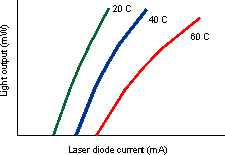
- As a result, as the temperature rises, the threshold value of the laser current at which light energy is emitted rises as well. As a result, the laser diode must be operated up to the threshold value of laser current so there is no light energy above this value.
- It is necessary to determine the laser current threshold value in order to provide a reliable operation.
V-I Characteristics
- In general, the laser diode’s forward voltage is about 1.5 V. And the forward voltage is affected by the operating temperature.
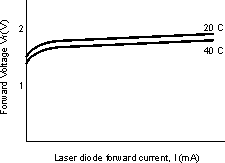
The above diagram shows the variation in current in a diode as a function of voltage.
Limitations of Laser diode
- As laser diodes are temperature-dependent, their activity is affected by changes in operating temperature.
- It is not ideal for high-power applications.
- These are expensive when compared to other diodes.
- These are harmful to our eyes.
Properties of Laser Diode
A laser diode’s emitted laser light has the following properties:
- Coherence – Coherence is a key parameter of lasers that exists as a result of stimulated emission. It basically means that the wavelengths of the transmitted light waves are in phase. When we think about ordinary light sources, such as LEDs, they do not have the property of coherence because they are emitted by the mechanism of spontaneous emission of a photon.
- Monochromaticity – The light emitted by this diode is monochrome, which means it has a single wavelength. Waves of a single wavelength indicate that the light produced is of a single color.
- Brightness – The brightness of a light is measured mainly by its power per unit surface area per unit solid angle. This diode produces a high-intensity, high-power light as a result of constant reflections. As a result, the system is capable of producing bright light.
- Directionality – Since laser light is strongly focused, the light released by a laser diode does not exhibit much divergence. The emitted photons in a laser diode undergo several reflections through the mirror, resulting in directionality. As the light deviates from its axis, it is skipped. As a result, only a highly concentrated light beam is obtained.
Types of Laser Diodes
- Double Heterostructured Laser Diodes – A heterostructured material is one that is sandwiched between two n-type and two p-type materials. This kind of laser diode is known as a double heterostructure (DH) laser diode due to the presence of heterostructure material. The active region of this diode is used for greater optical amplification, which is its key benefit.
- Quantum Well Laser Diodes – In this diode, the quantum well is a very thin middle layer. Quantum energy is responsible for greater efficiency by converting electrons from higher energy to lower energy.
- Separate Confinement Heterostructure Laser Diodes – There are two extra layers in addition to the three layers. These layers have a lower refractive index, which improves light emission.
- Vertical Cavity Surface-Emitting Laser Diodes – The optical cavity in this kind of laser diodes runs parallel to the axis of current flow.
Applications of Laser Diodes
- Laser diodes are commonly used in the defence and telecommunications industries.
- Since optical fibres need a highly directed beam, optical fibre communication often requires a laser beam for signal transmission.
- It is still widely used in laser printers.
- Laser diodes are used in surgical equipment in the medical field.
- The optical fiber transmission device is the most important realm in which laser diodes are used.
FAQs
The typical lifetime of a laser diode is somewhere between 25,000 to 50,000 hours.
Yes, a laser diode is very effective.
Blue laser is the most efficient laser diode with bandwidth 360-480nm wavelength.
Read More on Diodes
